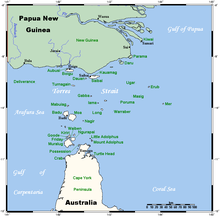Darnley Island (Queensland)
| Native name: Erub | |
|---|---|

A satellite image of Darnley Island
|
|

A map of the Torres Strait Islands showing Erub in the north-eastern waters of Torres Strait
|
|
| Geography | |
| Location | Torres Strait |
| Coordinates | 9°35′13″S 143°46′16″E / 9.587°S 143.771°E |
| Archipelago | Torres Strait Islands |
| Total islands | 1 |
| Administration | |
|
Australia
|
|
| State | Queensland |
| Demographics | |
| Population | 400 |
|
Darnley Island / Erub Island Queensland |
|
|---|---|
| Coordinates | 9°35′48″S 143°45′48″E / 9.59667°S 143.76333°ECoordinates: 9°35′48″S 143°45′48″E / 9.59667°S 143.76333°E |
| LGA(s) | Torres Strait Region |
Darnley Island or Erub in the native language, is an island formed by volcanic action and situated in the eastern section of the Torres Strait, Queensland, Australia. It is one of the Torres Strait Islands and is located near the Great Barrier Reef and just south of the Bligh entrance. The town on the island is also called Darnley but the locality is called Erub Island, both being within the local government area of Torres Strait Island Region.
Approximately 400 people live on Darnley Island. There are two stores, one school and a health centre. Accommodation is available through Norah's Guest House and the council run 'five star' dongas.
The effective community language is Brokan (Torres Strait Creole), though many people still speak Meriam Mir, the traditional language.
Darnley Island became better known around Australia in 2015 when the acting school principal asked via social media for donations of books to assist her primary school children and their education. Her efforts resulted in more than 18000 shares on Facebook and hundreds of books being sent to the island.
The island was named by Captain William Bligh in 1792 during his second breadfruit voyage to the Pacific, after his distant relative, the Earl of Darnley.
Christianity was first introduced to Darnley and the Torres Strait region by the London Missionary Society on 1 July 1871.
Before this, pearlers and beche-de-mer gatherers visited the island. Over many years, these industries attracted an influx of seamen from the Pacific Islands, the Philippines and Malaya, many of whom married local women and settled on the island.
...
Wikipedia

